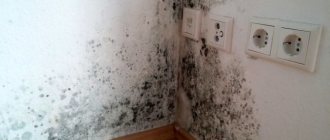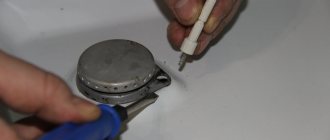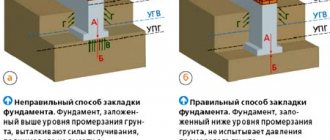Due to the movement of soil layers, the entire structure tilts, now in one direction, then in the other.
But the building itself stands solidly, thanks to a good foundation. If a crack appears in the wall of a house, this may mean that the foundation is doing its job very poorly. But there are many other reasons why cracks can occur even without the foundation being destroyed.
Causes of cracks in the house
It is believed that in the first five years after the construction of a house, cracks appear on the walls in 90% of cases - experts call this natural shrinkage, which does not pose any danger. But it also happens that the house is many years old, it is quite lived-in, all structures are regularly repaired, but cracks still appear. What is the reason for this phenomenon?
Firstly, cracks in the house may appear due to violations in the technology of constructing the walls themselves. For example, if the dressing of brickwork was carried out incorrectly.
Secondly, the phenomenon in question on the walls of a house may be caused by non-compliance with the sequence of construction work. For example, communication systems (water supply, sewerage) are often installed after the house has been built - the foundation has to be excavated, which negatively affects its quality characteristics.
Thirdly, settlement of the foundation often occurs - for example, due to compression of the foundation soil or too much pressure from the house on the foundation. This is possible if the construction of the foundation was carried out without preliminary calculations and design. The most common mistakes :
- During the construction of the foundation, geodetic surveys were not carried out, the nature of the soil was not studied;
- the ground resistance taken as a basis was erroneous and greatly overestimated;
- geodetic surveys at the construction site were carried out in the summer - the level of groundwater rise was not calculated;
- a mistake was made when choosing the type of foundation - for example, instead of a columnar one, a linear one was laid;
- calculations of the depth of the foundation and its thickness were not made - usually data from past construction projects are taken as the basis for these parameters;
- violations of the technology for laying a sand cushion under the foundation - for example, insufficient layer thickness or poor-quality sand compaction.
Please note: cracks in an old house can also occur due to structural changes in the building. Often, owners install a subfloor in a foundation that is not intended for this purpose, and the result will be displacement/shrinkage of the foundation base.
Required tools and materials
To seal cracks you will need the following material:
- wood glue in the consistency of thin sour cream, mixed with tooth powder or chalk chips;
- strips of cotton fabric, gauze, medical bandage, soaked in PVA glue (they can be replaced with fiberglass tape);
- cement mortar mixed with paint prevents moisture penetration;
- lime-cement mortar reinforced with mesh;
- sandpaper for grouting;
- primer;
- sealant;
- putty mixture;
- polyurethane foam;
- plaster for finishing.
- brush;
- brush;
- putty knife;
- construction mixer;
- foam sponge;
- gun for sealant and polyurethane foam.
In some cases, the work will additionally require a hammer, chisel and a hammer drill with attachments.
How to determine the danger level of cracks in your home
When even a small crack is detected, the main question arises: is it dangerous? Checking this is quite simple - you need to install a control beacon and observe the “behavior” of the crack for a long time. Professionals install special control beacons such as plate ones, which must be registered with the supervisory authorities. At home, when solving the problem yourself, you can use one of the following methods :
- stick a strip of paper onto the crack indicating the installation date;
- prepare a gypsum solution and place a strip of it on the crack.
And then all that remains is to wait and periodically check the status of the control beacon. It may take several months before any conclusions can be drawn - experts say that the crack needs to be monitored for 8-12 months.
How dangerous it is will be shown by a break in the control beacon - if there is such a phenomenon, then you will need to use complex technical solutions to eliminate the problem, if there is no break in the beacon, then you should not worry at all.
Where to contact
If cracks are detected, contact the management company. If the organization does not want to carry out and pay for repairs, it is necessary to go to the administration of the management company. In any case, the answer will come in writing. If the complaint is not considered there, you can call higher services:
- to the department of construction in the city;
- to the official housing inspection;
- to the prosecutor's office;
- to the judiciary;
- to Rospotrebnadzor.
Filing an application to the judicial authorities is the last step. To resolve the problem, the client must file a lawsuit against the companies that refused to restore and repair cracks in the walls. According to the law, complaints can be filed with a variety of organizations at once.
An inspection report must be attached to the complaint. If it was not carried out due to the refusal of the management company, you have the right to call an employee from special organizations.
ATTENTION! It is also necessary to provide photographs showing how the walls are cracking or documents of refusal of management companies.
Methods for eliminating cracks in the house
Different cracks can be fixed in certain ways - you must first determine the level of the problem.
Please note: if the control beacon shows a rapidly expanding crack, then no DIY methods for eliminating cracks will help - they will only have a short-term effect. Be sure to invite specialists to solve the problem, otherwise the consequences will be the most terrible - the collapse of the wall or the entire structure!
How to fix a crack in a house from the inside
If small cracks are found on the wall inside the house, then eliminating them is as easy as shelling pears. All you need is a primer and a special putty mesh. You need to act according to the instructions below:
- we clean the surface of building materials and finishing - the wall should be perfectly clean;
- we use a deep penetration primer (with exactly this marking!) - we cover the entire cleaned surface;
- glue the putty mesh onto the entire prepared surface;
Please note: a special mesh must be used to cover the entire area of damage on the wall - even small sections of cracks should not protrude beyond its boundaries.
- Apply a small layer of putty to the mesh and leave until completely dry.
Only after the putty layer has completely dried can you begin to grout the surface and glue wallpaper or other finishing materials.
Repairing a crack in a house from the outside of a wall
If small cracks appear on the outside of the house, you should proceed according to the same principle as in the above option. Procedure :
- the crack site is cleared of plaster or debris;
- apply a layer of deep penetration primer and glue the putty mesh onto it;
- apply putty. But! In case of eliminating cracks on external walls, it is advisable to use a special reinforced putty - it is resistant to the negative effects of atmospheric changes.
If the cracks on the outside of the walls of the house are not only in the plaster, but also extend to the brickwork, then you will have to put in much more effort. And in this case, the algorithm of actions will be as follows :
the plaster is completely removed from the wall;- a special metal mesh for plaster is screwed to the wall - this is done using bolts;
- a new layer of cement-sand mortar is applied to the mesh - the plaster must completely correspond to the thickness of the old layer, there should be no differences.
Please note: the metal mesh must cover the entire surface intended for applying a new layer of plaster. This way, the new plaster will not spread, which will allow finishing materials to be applied flawlessly.
Where to start repairing a brick wall
Repairing damage to the wall can only begin after it has been stabilized. This means that the fault is no longer growing. Otherwise, you will be wasting time and money on materials. We tell you how to diagnose.
- Apply a cement or plaster strip to the tear site and monitor its condition for several weeks. If no changes have occurred within 4-5 weeks, you can fix the problem.
- Instead of cement, attach plate beacons to the masonry and determine the dynamics of the rupture using the scale on them.
- For these purposes, use a paper strip glued with silicate glue. If it remains unharmed, you can begin work.
The last method is only suitable for dry rooms. The optimal length and width of the strips is 10*4 cm, if the damage is small (up to 10 mm). Before installing beacons, you must first remove plaster, dust and dirt.
Instagram @grinnish
Instagram @grinnish
The date of its installation is recorded on the lighthouse or in a special journal.
What to do if a crack in the house is spreading
This situation means only one thing - it is urgently necessary to take drastic measures to eliminate this problem. If you ignore all the recommendations of specialists and limit yourself only to the repair options described above, the result will be the collapse of the entire house. But even a beginner can cope with the work of eliminating such complex active cracks - the main thing is to strictly adhere to the following instructions :
- All the plaster on the wall at the location of the crack is knocked off - be sure to maintain a distance of 50 cm on each side of the crack.
- The crack is cleaned of mortar and dirt - this can be done with a metal spatula.
- The cleaned crack is filled with polyurethane foam.
- Fastening metal plates that will tighten the crack, preventing it from spreading further. The following points must be taken into account :
- the plate must be selected from thick, high-quality metal;
- to obtain an optimal result, you will need to tighten the crack with at least 3 plates, and if the crack is long, then you may need 4 or 5 metal plates;
- The plates are fastened using self-tapping screws, but using dowels.
After applying the fastening metal plates, you can continue working according to the usual algorithm - priming/fixing the reinforcing mesh/applying new plaster.
But keep in mind that such measures serve as a temporary measure, since without a specific formation it will not be possible to determine the cause of the appearance of active cracks. Most often, in the future it will be necessary to carry out corrective work on the foundation - it will either be strengthened/strengthened, or the walls/roof of the house will be raised and the foundation will be completely replaced.
Removing minor damage
Before starting repairs, you should thoroughly study the defect. The width and depth of the cracks determines the approach that will be used in the process of correcting the problem. First of all, the cracks are widened, if necessary, the old plaster is removed, the surface is prepared for repairs - priming the surface, and then plastering the area.
There is another, simpler way. The crack is tightly filled with tile adhesive, a “patch” of serpyanka reinforcing mesh is applied on top, then everything is covered with tile adhesive or finishing putty.
These methods are good for surface cracks. But when the damage reaches the brickwork, these measures will not be enough.
Preventing cracks in the house
To avoid having to deal with cracks in your home, you should familiarize yourself with the prevention of this phenomenon.
Firstly, if you are just designing a house, you need to take several points into account:
- geodetic surveys must be carried out - this will help determine the type of soil, the location of aquifers, and the depth of groundwater;
- Even at the design stage, it is necessary to provide for the possibility of building a subfloor/cellar under the house - this will entail serious design changes;
- It is imperative to familiarize yourself with the depth of soil freezing - the depth of the foundation will depend on this.
Secondly, when buying an old house, pay attention to the existing walls, invite specialists to assess their condition - often small cracks hide serious problems in the stability/reliability of the entire structure. One more point - there should be a blind area around the entire house - this will prevent moisture from entering the foundation, and therefore will prevent its destruction.
We recommend reading: Do-it-yourself foundation blind area
Thirdly, if you want to add a second floor to an already inhabited house, you should consult with professionals about the advisability of such actions. The fact is that each foundation is designed for a certain load and exceeding it leads to the appearance of cracks.
Cracks in the house are not a reason for panic, but just an impetus for action. Even an absolute beginner in the construction business can cope with the work described above, but it is much easier to prevent the appearance of cracks in advance.
( 78 votes, average: 4.72 out of 5)
DIY bathroom waterproofing
Do-it-yourself two-level stretch ceiling
Related Posts
How to strengthen the foundation of a building
The sequence of actions is as follows.
- Creation of a ditch around the perimeter of the entire structure. Its depth should be greater than the depth of the foundation.
- The soil is dug out from under the first foundation so that the concrete gets under it.
- Reinforcement and pouring of concrete belt. The reinforcement rods are stuck into the walls of the ditch by 15-20 cm. In the old foundation you need to drill holes for the reinforcement and weld it with the rods.
After sealing large cracks, the condition of the repaired surface is regularly monitored for several months. The video shows an algorithm for restoring cracked masonry using reinforcement.
What is the best way to cover up cracks in a load-bearing block wall?
Sealing cracks in interior block walls includes 2 methods of work. The reason for the presence of defects is often the lack of reinforcement. The first method is done like this:
- The gap is cleaned and widened if necessary.
- For strengthening, anchors in the shape of the letter E are used, secured with dowels.
- Introduce pieces of broken cinder block into the plaster solution, make them small, then apply the product to the crack.
Second option:
- The flaw is expanding.
- Primed.
- Sealed with mortar.
The reason for the presence of defects is often the lack of reinforcement.











